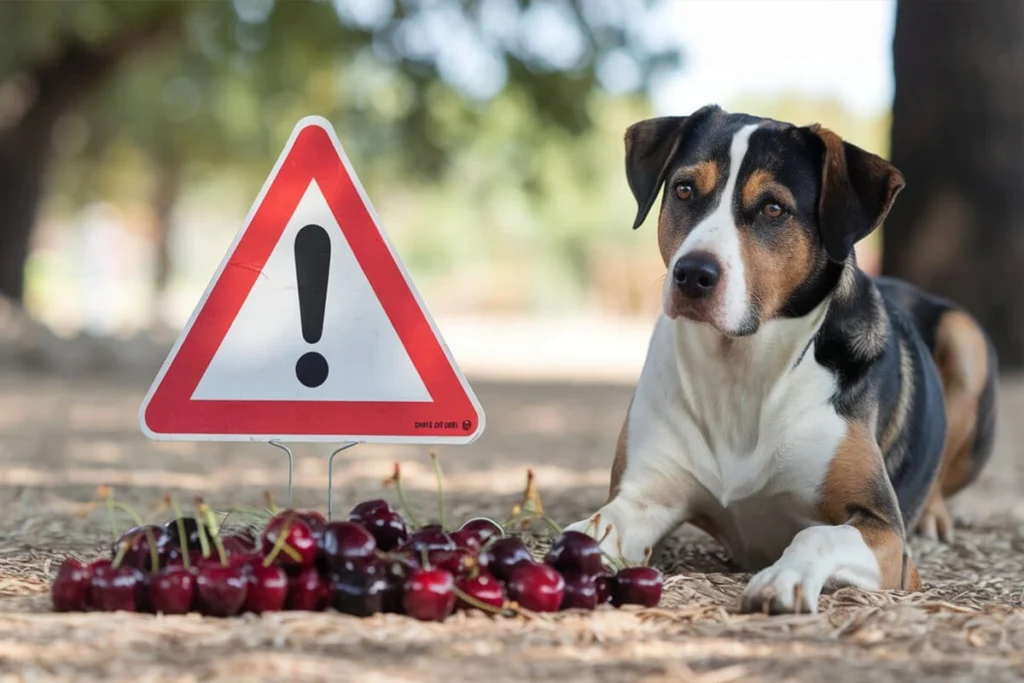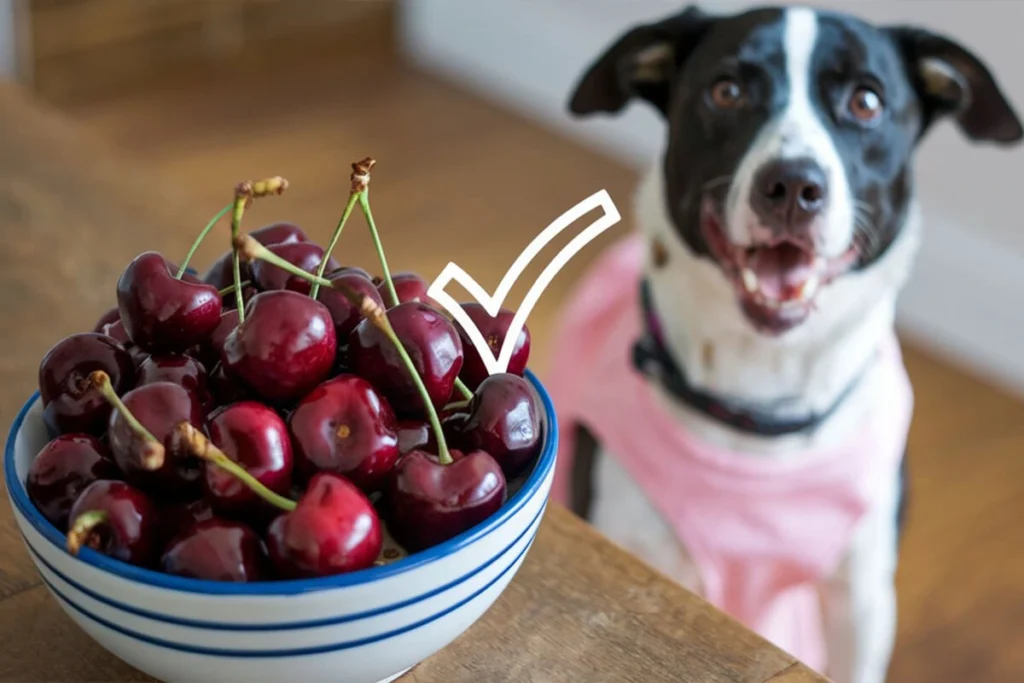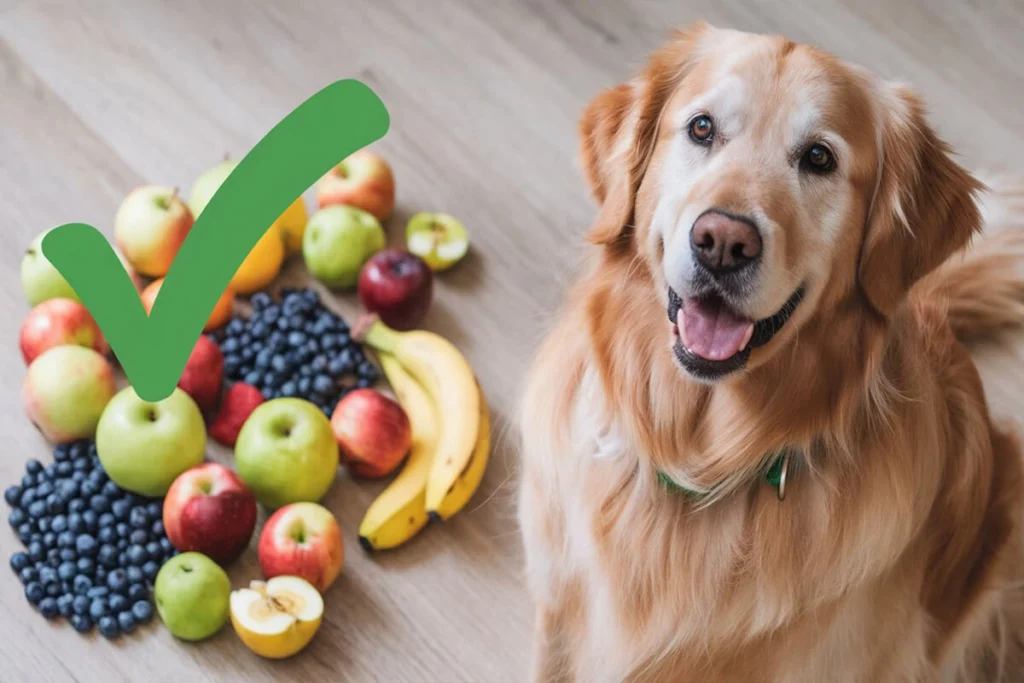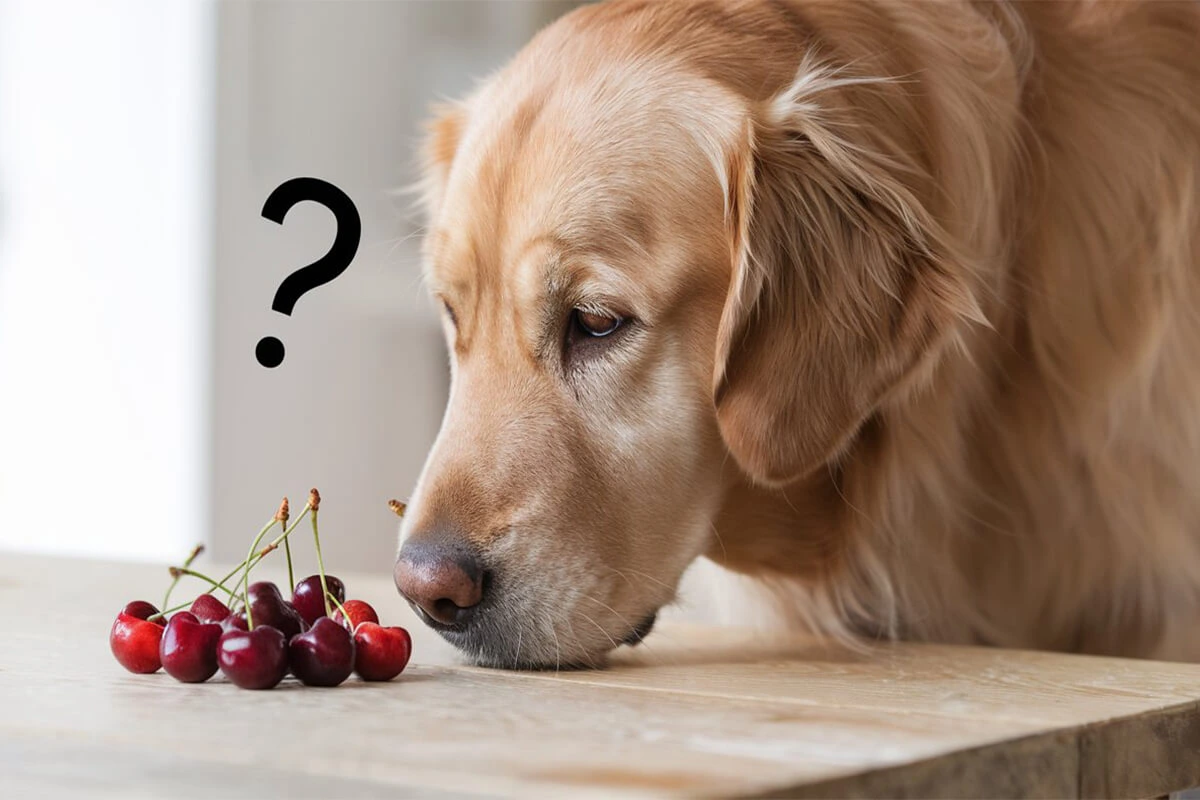Can dogs have cherries? Many dog owners wonder whether this sweet and juicy fruit is safe for their furry companions. While cherries contain beneficial nutrients like vitamins A and C, fiber, and antioxidants, they also pose serious health risks for dogs. The presence of cyanide in cherry pits, stems, and leaves makes them potentially toxic, and even the flesh of the fruit can cause digestive issues if consumed in large quantities.
It’s important to know the good and bad things about giving cherries to dogs. This helps you take better care of your pet. Feeding your dog cherries without knowing the dangers could lead to choking, intestinal blockages, or even poisoning. In this guide, we will explore the most important facts about cherries and dogs, including the potential health risks, veterinary advice, and safe fruit alternatives. By the end, you’ll have a clear answer on whether cherries belong in your dog’s diet.
Are Cherries Safe for Dogs?
Overview of Cherries and Their Nutritional Benefits
Cherries offer a variety of nutrients that support overall health. These small, vibrant fruits contain essential vitamins like vitamin A and vitamin C, which help boost the immune system and promote healthy skin. They also provide fiber, which supports digestion, and antioxidants, known for reducing inflammation and fighting free radicals. Many health-conscious people enjoy cherries for their benefits, so it’s natural to wonder, can dogs have cherries too?
While cherries contain valuable nutrients, the risks often outweigh the benefits when it comes to dogs. Unlike humans, dogs process certain fruits differently, and not all human foods suit their digestive systems. Before offering cherries to your dog, it’s important to understand whether their nutritional value justifies the potential dangers.
Why Some Dog Owners Consider Feeding Cherries to Their Pets
Many dog owners believe cherries make a healthy, low-calorie snack for their pets. Since cherries contain natural sugars, they offer a sweet and refreshing treat, especially during hot summer days. Some people assume that since dogs can safely eat other fruits like apples, blueberries, and bananas, cherries must also be safe in moderation.
Another reason pet owners consider giving their dogs cherries is the potential health benefits. Some believe the antioxidants in cherries help reduce inflammation, especially in older dogs with arthritis or joint pain. Others may think the fruit’s fiber content aids digestion. However, before feeding cherries to a dog, owners must consider the risks, including cherry pits, stems, and leaves, which contain cyanide. Even seedless cherries could cause digestive problems if given in large amounts.
General Safety Concerns Regarding Cherries and Dogs
Dog owners need to know that cherries pose several health risks, even if they remove the pits. The biggest danger comes from cyanide poisoning, which occurs when a dog consumes cherry pits, stems, or leaves. Cyanide blocks the body’s ability to absorb oxygen, leading to serious symptoms like difficulty breathing, dilated pupils, and red gums.
Even if a dog only eats the cherry flesh, safety concerns remain. Choking hazards can arise from whole cherries, especially in small breeds. The fruit’s high sugar content could also lead to stomach upset, diarrhea, or weight gain if eaten too often. Additionally, artificial cherry-flavored products, such as syrups or candies, often contain xylitol, an artificial sweetener that is highly toxic to dogs.
Dog owners who ask, can dogs have cherries? should consider both the benefits and risks before offering this fruit to their pets. While cherries may seem like a tempting snack, several safer fruit alternatives provide similar health benefits without the dangers.
Health Risks of Cherries for Dogs
Cyanide in Cherry Pits
Many dog owners wonder, can dogs have cherries safely if they eat just one or two? The biggest danger comes from cherry pits, which contain cyanogenic compounds that release cyanide when chewed or broken. Cyanide is an extremely toxic substance that prevents cells from using oxygen properly, leading to severe health issues or even death in extreme cases.

Even a small amount of cyanide can cause serious harm, depending on the dog’s size and how much they consume. If a dog bites into a cherry pit and crushes it, the cyanide quickly enters their system. The stems and leaves of cherries also contain cyanogenic glycosides, making them just as dangerous. If a dog eats multiple cherry pits, toxicity levels can rise quickly, leading to cyanide poisoning.
If a dog accidentally eats a whole cherry, the pit might pass through their digestive system without breaking, minimizing the risk of cyanide exposure. However, owners should never take that chance, as even one crushed pit can be dangerous. Since most dogs tend to chew food rather than swallow it whole, the risk remains high.
Cherry Poisoning in Dogs
When a dog eats cherry pits, stems, or leaves, cherry poisoning symptoms can appear within a short period. Dog owners should watch for the following signs of cyanide poisoning:
- Difficulty breathing – Cyanide prevents oxygen from reaching cells, leading to respiratory distress.
- Bright red gums – This occurs because oxygen builds up in the bloodstream without being properly absorbed.
- Dilated pupils – A dog’s pupils may become unusually large as their body reacts to cyanide exposure.
- Lethargy and weakness – Dogs may appear tired, weak, or uncoordinated due to reduced oxygen levels.
- Shock or seizures – In severe cases, cyanide poisoning can cause sudden collapse, tremors, or even seizures.
If a dog shows any signs of cherry poisoning, owners must seek emergency veterinary care immediately. Cyanide toxicity can progress rapidly, so early intervention is crucial. Veterinarians may administer oxygen therapy, induce vomiting, or provide antidotes to counteract the poison.
Other Risks
Even if a dog avoids cyanide poisoning, cherries still pose several other dangers. Many dog owners think removing the pits makes cherries safe, but this isn’t entirely true. The flesh of cherries contains natural sugars that can upset a dog’s stomach if eaten in large amounts.
Some of the biggest non-toxic risks include:
- Choking hazard – Whole cherries can get stuck in a dog’s throat, especially in small breeds. Even pitted cherries may pose a risk if swallowed too quickly.
- Intestinal blockage – Cherry pits, if swallowed, can cause obstructions in the digestive tract, leading to vomiting, constipation, or severe discomfort.
- Digestive issues – Some dogs have sensitive stomachs, and cherries can trigger diarrhea, gas, or bloating due to their sugar and fiber content.
- Toxic additives in processed cherries – Cherry-flavored products like candies, jams, and syrups often contain xylitol, an artificial sweetener that is highly toxic to dogs.
Dog owners who ask, can dogs have cherries safely if they’re seedless? should remember that while pit-free cherries reduce the risk, they don’t eliminate it entirely. Many safer fruit alternatives exist, offering the same nutrients without the dangers. Owners should always prioritize their dog’s health and choose snacks that won’t put them at risk.
Can Dogs Eat Cherries Without Pits?
Are Pitted Cherries Safe in Small Amounts?
Many dog owners ask, can dogs have cherries if the pits are removed? While pitted cherries eliminate the cyanide risk, they still pose other health concerns. Even without the pits, cherries contain natural sugars and fiber, which can upset a dog’s stomach, especially if eaten in large amounts.

Feeding a dog a small piece of pitted cherry on rare occasions may not cause harm, but owners must watch for signs of digestive distress such as diarrhea, bloating, or gas. Some dogs have sensitive stomachs and react poorly to new foods, even ones considered safe. Additionally, cherries contain malic acid, which may irritate a dog’s digestive tract, leading to discomfort or loose stools.
Size and breed also play a role in whether cherries are safe. A small dog consuming even a few cherries could experience stomach upset more quickly than a large dog. Since dogs don’t need cherries to stay healthy, safer fruit alternatives like blueberries, apples, or bananas provide the same nutritional benefits without the risk.
Differences Between Fresh, Dried, and Canned Cherries
Dog owners who wonder, can dogs have cherries in different forms? should understand that not all cherries are created equal. The way cherries are processed changes their nutritional value and safety for dogs.
- Fresh Cherries – Fresh, pitted cherries contain natural vitamins and antioxidants, but they still have high sugar content and can cause digestive issues if eaten in excess. Even fresh cherries may lead to stomach upset, so moderation is key.
- Dried Cherries – Dried cherries are even riskier because the drying process removes water and concentrates sugar levels. A small handful of dried cherries contains far more sugar than a few fresh cherries. Excess sugar can lead to weight gain, diabetes, and digestive upset in dogs.
- Canned or Preserved Cherries – Canned cherries often contain added sugars, syrups, and preservatives that are unhealthy for dogs. Many processed cherries also include artificial sweeteners like xylitol, which is highly toxic and can cause life-threatening reactions in dogs, including seizures and liver failure.
Since dried and canned cherries pose more risks than benefits, dog owners should avoid them entirely. If considering fresh cherries, always remove the pits, stems, and leaves, and offer only a tiny amount to see how the dog reacts.
Why Artificial Cherry-Flavored Foods Should Be Avoided
Artificially flavored cherry products may seem harmless, but they are dangerous for dogs. Many cherry-flavored candies, drinks, yogurts, and syrups contain chemical additives, artificial flavors, and sweeteners that dogs cannot safely digest.
One of the biggest dangers in artificial cherry products is xylitol, a sugar substitute that can cause a sudden drop in blood sugar (hypoglycemia), seizures, liver damage, or even death in dogs. Even a small amount of xylitol can trigger severe health complications.
Beyond xylitol, artificial cherry products often contain:
- Excess sugar – Too much sugar can lead to obesity, diabetes, and dental problems in dogs.
- Artificial dyes – Chemicals like Red 40 or preservatives may cause allergic reactions or digestive issues in some dogs.
- Alcohol-based extracts – Some cherry-flavored syrups or medicines contain alcohol, which is toxic to dogs even in small amounts.
Dog owners should never assume that cherry-flavored products are safe. Instead, they should focus on providing natural, dog-friendly fruits that offer health benefits without unnecessary risks. If looking for a sweet treat, fresh blueberries, strawberries, or watermelon make much better choices than anything cherry-flavored.
Dog owners who ask, can dogs have cherries in any form? should carefully consider the potential dangers. While fresh, pitted cherries may not be toxic in small amounts, other forms of cherries—dried, canned, or artificial—pose serious risks that aren’t worth taking.
Veterinary Advice on Cherries for Dogs
What Vets Say About Feeding Cherries to Dogs
Many dog owners ask veterinarians, can dogs have cherries safely? Vets generally do not recommend cherries as a treat for dogs due to the numerous risks involved. While the flesh of the cherry contains vitamins, fiber, and antioxidants, the potential dangers far outweigh any benefits. The presence of cyanide in the pits, stems, and leaves, along with choking hazards and digestive issues, makes cherries an unsafe choice for most dogs.

Veterinarians emphasize that dogs do not need cherries in their diet. Dogs get all the necessary nutrients from a well-balanced dog food diet, so there’s no reason to take risks with a fruit that could cause harm. Vets also point out that even if a dog eats pitted cherries, the high sugar content may lead to stomach upset or long-term health issues like obesity and diabetes.
Instead of feeding cherries, vets suggest safer fruit alternatives that provide similar benefits without toxicity risks. Fruits like blueberries, apples (without seeds), bananas, and watermelon are much better choices for dogs and offer essential nutrients without the danger of cyanide or choking hazards.
Steps to Take if a Dog Accidentally Eats Cherry Pits
If a dog eats a cherry pit, quick action can prevent serious health issues. The level of danger depends on the number of pits consumed, the dog’s size, and whether the pit was chewed or swallowed whole. Here’s what to do if a dog eats cherries with pits:
- Check for Remaining Cherries – If the dog got into a bowl of cherries, estimate how many they ate and whether they chewed the pits or swallowed them whole. Chewed pits are more dangerous because they release cyanide.
- Watch for Immediate Symptoms – Signs of cyanide poisoning can develop quickly. Look for difficulty breathing, bright red gums, dilated pupils, or weakness. If any of these symptoms appear, seek emergency veterinary care.
- Prevent Further Ingestion – Remove any remaining cherries to stop the dog from eating more. Keep cherry pits and stems out of reach in the future.
- Contact a Veterinarian – Call a vet immediately and explain the situation. Provide details such as the number of pits consumed, the dog’s weight, and whether they chewed the pits. The vet may recommend monitoring the dog at home or bringing them in for treatment.
- Monitor Digestion – If a dog swallows a cherry pit whole, it might pass through their digestive system without breaking. However, if the dog experiences vomiting, constipation, or a bloated stomach, it could indicate an intestinal blockage, which requires veterinary attention.
Quick action can save a dog from serious health complications. Even if symptoms don’t appear right away, always check with a vet to ensure the dog is safe.
When to Seek Emergency Veterinary Care
If a dog eats cherry pits, certain symptoms indicate a medical emergency. Dog owners should take their pet to a veterinarian immediately if they notice:
- Difficulty breathing – Cyanide blocks oxygen absorption, leading to labored breathing or gasping.
- Bright red gums – A telltale sign of cyanide poisoning, caused by oxygen buildup in the blood.
- Dilated pupils – Enlarged pupils can indicate neurological distress or poisoning.
- Lethargy or collapse – Weakness, lack of movement, or sudden collapse are serious warning signs.
- Seizures or tremors – Uncontrolled shaking, twitching, or convulsions may occur in severe cases of cherry poisoning.
- Persistent vomiting or bloating – If a dog struggles to keep food down or has a swollen stomach, an intestinal blockage could be the cause.
Immediate veterinary care can make a life-saving difference for a dog experiencing cherry poisoning or an intestinal obstruction. If a vet visit is not possible right away, calling an emergency pet poison hotline can provide urgent guidance on what steps to take.
Dog owners should never assume that cherries are safe for dogs, even if the dog seems fine after eating one. Since cyanide poisoning progresses quickly, seeking veterinary care at the earliest signs of distress is crucial. If a dog has eaten multiple cherry pits or shows any symptoms of poisoning, don’t wait—go to the vet immediately.
Safe Fruits for Dogs as Alternatives
List of Dog-Friendly Fruits
Dog owners who wonder, can dogs have cherries, or are there safer alternatives? should know that many dog-friendly fruits provide similar nutritional benefits without the risks. Instead of feeding cherries, consider these safe fruit options:

- Blueberries – Packed with antioxidants, fiber, and vitamin C, blueberries support brain health and immune function in dogs. They are small, bite-sized, and safe to feed whole.
- Apples (without seeds) – Apples provide vitamin A, vitamin C, and fiber, making them a great crunchy snack. Make sure to take out the seeds and the middle part of the fruit, because they can have cyanide, which is harmful.
- Bananas – These are rich in potassium, fiber, and vitamins, helping with digestion and muscle function. Because they have a lot of sugar, it is best to give them only a little bit.
- Watermelon (seedless) – Hydrating and full of vitamins A, B6, and C, watermelon is a great summer treat. Always remove the seeds and rind before feeding.
- Strawberries – These contain antioxidants, fiber, and vitamin C, promoting healthy skin and a strong immune system. Serve them in small pieces to prevent choking.
- Pumpkin (plain and cooked) – A great source of fiber and beta-carotene, pumpkin supports digestion and gut health. Avoid canned pumpkin with added sugars or spices.
- Pineapple (small amounts, without the core) – High in vitamin C, bromelain (a digestive enzyme), and fiber, pineapple aids digestion but should be fed in small portions due to its acidity.
These fruits are nutrient-rich, low-risk, and widely recommended by veterinarians as safe treats for dogs. Always introduce new fruits gradually to ensure they don’t cause digestive upset.
Nutritional Benefits of Safer Fruit Options
Many dog-friendly fruits offer valuable nutrients that support overall canine health. While cherries have some beneficial vitamins and antioxidants, the risks make them unsuitable for dogs. The following safe fruits provide similar or even better nutritional value without the toxicity concerns:
- Antioxidants (Blueberries, Strawberries, Apples) – These help fight free radicals, reduce inflammation, and support brain function, particularly in aging dogs.
- Fiber (Pumpkin, Apples, Bananas) – Supports healthy digestion, prevents constipation, and promotes gut health.
- Vitamin C (Blueberries, Strawberries, Pineapple) – Boosts the immune system and helps reduce inflammation.
- Potassium (Bananas, Watermelon, Pumpkin) – Helps maintain muscle and nerve function and supports heart health.
- Hydration (Watermelon, Pineapple, Pumpkin) – Fruits with high water content help keep dogs hydrated, especially in hot weather.
By choosing safe, nutrient-dense fruits, dog owners can boost their pet’s health without exposing them to unnecessary risks. These fruits make great treats, can be added to meals, or even used as rewards during training.
How to Introduce New Fruits to a Dog’s Diet Safely
When introducing a new fruit, owners should take a slow and careful approach to prevent digestive upset or allergic reactions. Even dog-safe fruits can cause issues if introduced too quickly or fed in large amounts. Follow these simple steps to safely add fruits to a dog’s diet:
- Start Small – Offer a tiny piece of the new fruit and watch for any signs of digestive upset, such as diarrhea, gas, or vomiting.
- Check for Allergic Reactions – Observe for itching, swelling, or excessive licking, which may indicate an allergy. If any reaction occurs, stop feeding the fruit immediately.
- Remove Any Unsafe Parts – Always remove seeds, pits, cores, and rinds to prevent choking hazards and toxicity risks.
- Feed in Moderation – Even healthy fruits contain natural sugars, so they should only make up 10% or less of a dog’s daily calorie intake.
- Mix with Regular Food – Some fruits, like pumpkin or bananas, can be mashed and mixed into a dog’s regular food for added nutrition.
- Monitor for Digestive Issues – If a dog experiences diarrhea, bloating, or discomfort, reduce or stop feeding the fruit and consult a veterinarian.
- Avoid Artificially Flavored Fruit Products – Stay away from fruit-flavored treats with added sugars, artificial sweeteners (like xylitol), or preservatives that can harm dogs.
Since every dog reacts differently to new foods, gradual introduction and close monitoring are key. If a dog has a sensitive stomach or underlying health conditions, consult a veterinarian before adding new fruits to their diet.
Instead of wondering can dogs have cherries safely?, owners should focus on proven dog-friendly fruits that provide health benefits without risks. By following safe feeding practices, they can offer nutritious, tasty treats that support their dog’s well-being.
Conclusion
Many dog owners wonder, can dogs have cherries, or are they too risky? While the flesh of a cherry contains some beneficial nutrients, the potential dangers outweigh any possible health benefits. Cherry pits, stems, and leaves contain cyanide, which can be toxic if a dog chews or consumes them in large amounts. Even pitted cherries can cause digestive issues due to their high sugar and fiber content.
Veterinarians strongly advise against feeding cherries to dogs, especially since many safer fruit options provide the same vitamins and antioxidants without the risks. Fruits like blueberries, apples (without seeds), bananas, and watermelon offer fiber, hydration, and essential nutrients while being much safer.
If a dog accidentally eats a cherry pit, owners should act quickly by monitoring for signs of cyanide poisoning, including difficulty breathing, bright red gums, or lethargy. In cases of severe symptoms, immediate veterinary care can save a dog’s life. Even if the dog shows no immediate distress, consulting a vet ensures proper precautions are taken.
Instead of worrying about whether dogs can have cherries, owners should focus on offering safe, healthy treats. Introducing new fruits gradually and in moderation helps prevent digestive upset while ensuring dogs get the best possible nutrition. By avoiding risky foods like cherries and choosing vet-approved alternatives, owners can keep their dogs happy, healthy, and safe.
Read More About Dogs and Breeds from Here!
Looking for Dog Collars With Engraved Name in it ? Check This Article.
Find Out Why a Dog Collar is the Best Gift you can give to your Beloved Pup From Here.
Find Some Good Stuff For your Dog on PetMD Official.

1 thought on “Can Dogs Have Cherries? Top 8 Facts Dog Owners should know”
Comments are closed.